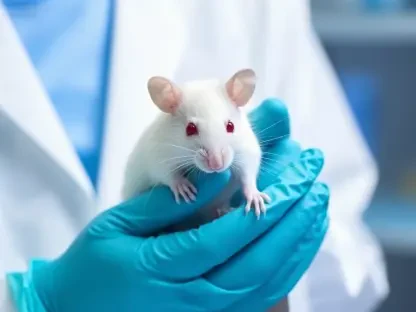Fixed version:
In a landmark move that could redefine the battle against pediatric cancer, the U.S. Department of Health and Human Services (HHS) has announced a dramatic increase in funding for research, with a sharp focus on leveraging artificial intelligence (AI) to drive progress. This initiative, spurred by an Executive Order from President Trump, elevates the annual budget of the Childhood Cancer Data Initiative (CCDI) at the National Institutes of Health (NIH) from $50 million to $100 million, signaling a profound commitment to addressing a disease that stands as a leading cause of death among children in the United States.
Revolutionizing Research with AI Technology
The cornerstone of this enhanced funding is the integration of AI into childhood cancer research, a tool poised to transform how complex medical data is analyzed and applied. AI’s capacity to process vast datasets, including electronic health records and clinical trial information, offers unprecedented speed in identifying patterns that could lead to breakthroughs. This approach is particularly vital for tackling rare and intricate cancers such as leukemias, where traditional research methods often fall short. By enabling precision medicine, AI can help tailor treatments to individual patients, potentially improving outcomes and reducing side effects. The promise of early risk detection and streamlined clinical strategies underscores the transformative potential of this technology in addressing a public health challenge that affects thousands of young lives each year, providing hope for more effective interventions.
Beyond its analytical power, AI is set to redefine the pace of discovery in pediatric cancer research by bridging gaps that have long hindered progress. The ability to sift through massive amounts of data in real time allows researchers to uncover insights that might otherwise take years to emerge. This is especially critical given the alarming statistic that childhood cancer incidence has increased by over 40% since historical baselines in the mid-1970s. With the CCDI, established in 2019, now backed by doubled resources, the focus is on learning from every child’s experience to build a comprehensive understanding of the disease. This data-driven strategy aims to enhance not only treatment options but also survivorship, ensuring that children who beat cancer can lead healthier lives post-recovery. The infusion of AI into this initiative marks a significant leap toward a future where cures are discovered faster and more efficiently.
Fostering Collaboration Across Sectors
A key element of this funding increase is the emphasis on collaboration between public institutions and private entities, reflecting a broader trend in healthcare toward interdisciplinary partnerships. By teaming up with private companies that specialize in AI technology, the HHS and NIH aim to maximize innovation in pediatric cancer research. These partnerships are designed to ensure that the latest advancements in machine learning and data analytics are applied directly to the challenges of diagnosing and treating childhood cancers. This cross-sector approach not only amplifies the impact of the $100 million investment but also sets a precedent for how complex health issues can be tackled through shared expertise. The collaborative model is expected to accelerate the translation of research findings into real-world solutions, bringing hope to families grappling with this devastating illness.
Moreover, this collaborative framework seeks to address systemic shortcomings that have historically slowed progress in combating childhood cancer. By uniting government agencies with private innovators, the initiative creates a dynamic ecosystem where ideas and resources flow freely, fostering an environment ripe for groundbreaking discoveries. The involvement of private sector expertise ensures that cutting-edge tools are not just theoretical but are actively integrated into research protocols. This synergy is particularly important given the unique challenges of pediatric cancer, where the rarity of certain conditions often limits the scope of traditional studies. Through these partnerships, the goal is to build a robust pipeline of innovation that can sustain long-term advancements, ensuring that every dollar invested yields tangible benefits for young patients and their families facing unimaginable hardship.
Prioritizing Ethics Alongside Innovation
While the potential of AI to revolutionize pediatric cancer research is immense, the HHS has placed a strong emphasis on maintaining ethical standards throughout this initiative. A critical assurance is that parents will retain full control over their children’s health data, even as it is utilized for research purposes. This commitment to data privacy addresses valid concerns about how sensitive information is managed in an era of rapid technological advancement. Striking a balance between pushing scientific boundaries and protecting individual rights, this policy ensures that the pursuit of cures does not come at the expense of trust. Such measures are essential for fostering public confidence in the use of AI, especially when dealing with the personal and emotional context of childhood illness.
In addition to privacy safeguards, the ethical framework of this initiative underscores a broader responsibility to use technology in a way that prioritizes patient well-being. The focus on parental consent reflects an understanding that innovation must be paired with compassion, particularly in a field as sensitive as pediatric oncology. This approach also serves as a model for future health research endeavors, demonstrating that cutting-edge tools like AI can be deployed without compromising fundamental values. As the CCDI expands its reach with this doubled funding, the commitment to ethical data use will likely shape how similar programs are structured, ensuring that the drive for scientific progress remains grounded in respect for the families at the heart of this fight. This balance is a testament to a thoughtful strategy that values both results and integrity.
Voices of Commitment and Urgency
The human dimension of this funding increase is vividly captured in the statements from high-ranking officials who are championing this cause with passion and resolve. Leaders such as HHS Secretary Robert F. Kennedy, Jr., NIH Director Jay Bhattacharya, and National Cancer Institute Director Anthony Letai have articulated a shared vision of eradicating childhood cancer through American ingenuity and state-of-the-art science. Their words convey a deep sense of urgency, emphasizing that the current systems have not kept pace with the growing crisis of pediatric cancer. This collective determination, supported by policy action and substantial resources, highlights the gravity of a public health issue that continues to devastate countless families. Their unified stance serves as a powerful reminder of the stakes involved and the need for immediate, impactful change.
Further amplifying this message is the personal dedication evident in the leadership’s approach to this initiative, which resonates with a profound sense of purpose. The emotional weight of supporting young patients and their families is a recurring theme in their public remarks, reflecting a commitment that goes beyond mere policy to touch on human compassion. This perspective is particularly poignant given the sobering reality that childhood cancer remains a leading cause of disease-related mortality among children in the nation. By aligning technological innovation with heartfelt resolve, these officials are framing the fight against pediatric cancer as both a scientific challenge and a moral imperative. Their voices add a layer of sincerity to the initiative, reinforcing the belief that with the right tools and determination, significant progress is within reach for those affected by this tragic disease.
Building a Hopeful Future for Young Patients
Looking back, the decision to double funding for the CCDI marked a pivotal moment in the ongoing struggle against childhood cancer, reflecting a bold step taken by the HHS and NIH under decisive leadership. The integration of AI into research efforts, supported by a $100 million annual investment, set a new standard for how technology could be harnessed to address pressing health crises. Collaborative partnerships with private entities and a steadfast commitment to ethical data practices further strengthened the foundation of this initiative, ensuring that progress was both innovative and responsible. As officials rallied behind this cause with unwavering dedication, their efforts underscored a national resolve to prioritize the well-being of the youngest and most vulnerable. Moving forward, the focus must remain on translating these resources into tangible outcomes—faster diagnoses, more effective treatments, and improved survivorship. Continued investment and cross-sector cooperation will be crucial to sustaining momentum, offering a brighter horizon for children and families battling this relentless disease.









